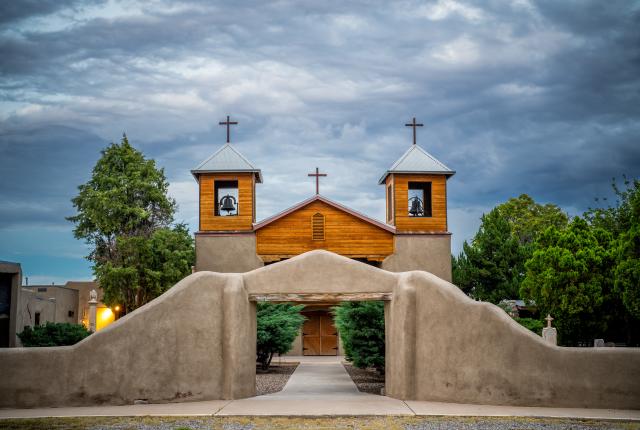"PEOPLE ARE DRAWN TO THE MIRACLES Jesus performed,” Father Michael Demkovich tells a dozen parishioners at Tomé’s Immaculate Conception Church during a Wednesday morning Mass. “But that wasn’t why he was sent. He was sent to share the good news, as we must, as families, and as a community.”
Within its adobe walls, Immaculate Conception holds both miracles and good news. Underscoring both is the quiet strength of a small community near Los Lunas whose faith digs deep into the soil of the Río Grande Valley. From a pilgrimage trail up the nearby Cerro de Tomé to a $1 million preservation funded almost entirely by parishioners, the church draws enough followers that Sunday services can get a little crowded.
Ramón Torres was among the faithful who helped with the 10-year renovation, completed in 2020, which included rebuilding one wall, refurbishing the pews, and firming up bouncing floors that, one helper said, are now strong enough to land a helicopter on.
“The bell towers came down in the 1960s,” Torres says. “There were cracks in the walls, and the bells weighed more than a thousand pounds. It was a safety hazard. We parishioners always wanted those bells to go back up.”
Read more: The most common building material on earth comes with a few catches.
They returned the bells to their glory, in part after parishioners dealt with layers of cement plaster whose sheer weight posed a menace to the walls beneath. “We took off about four inches of plaster and concrete and found our walls are in pretty good shape,” Torres says. The walls were also sitting, surprisingly, on rock foundations four feet deep and four feet wide, rather than on bare earth, as consultants had feared.
Those foundations were laid in 1739, with the church’s dedication in 1754, making it one of the oldest parishes in the Archdiocese of Santa Fe. Its early priests visited missions as far away as White Oaks, to the south, and Manzano, to the east. Cerro de Tomé, or Tomé Hill, had long served as a pilgrimage site, but it became a more visible one after World War II, when returning soldier Edwin Berry organized the placement of three large crosses atop it. A member of the Penitente Brotherhood, he called the dormant volcano an honorable place for worship: “Open to all, at all times, and no collection plate.”
The trail now attracts Holy Week devotees, but also daily walkers seeking both redemption and a good workout. (It rises 400 feet in one-half mile.) After its purchase by developers in 1968, the land could have been blocked off to everyone. The Town of Tomé Land Grant negotiated the hill’s return in 2013, securing public access to it, perhaps forever.
“Our youth group walked it in the late afternoon of this Good Friday to collect trash,” Demkovich says.
As for miracles, consider the 1722 life-size bulto of Christ, laid out within a framework depicting the Holy Sepulchre, that resides in the south transept. Heavy rains in 1844 forced the Río Grande to surge past its banks and stream toward the church. Father Jean Baptiste Rallière and parishioners raced to save the church’s artworks. But when they got to the bulto, Demkovich says, “What six men could previously move, 20 could not. The belief was that it was a miracle. Christ was saying, ‘I’m staying here.’ ”
Read more: These books can help you discover even more of New Mexico’s sacred places.
TOMÉ CHURCH RENOVATION
Watch a short video summarizing the work done to preserve and improve Immaculate Conception Church in Tomé at nmmag.us/tomereno.
A FEW MORE
Continue your exploration by visiting these historic churches.
In 1885, community leaders in Las Vegas, New Mexico, banded together to purchase a 22,000-pound pipe organ for Our Lady of Sorrows, a red sandstone Gothic Revival church just off the Plaza. Intended for the Cathedral Basilica of St. Francis, in Santa Fe, it didn’t fit, so its 1,589 wooden and metal pipes, ranging from pencil-size to 30 feet tall, landed in Vegas. Time then took its toll. Before Covid, a series of concerts helped raised $250,000 to accomplish just half of the repairs required. The effort will likely pick up steam this year, says organist Bonnie Bolton. “It’s just an amazing, amazing instrument to hear,” she says. “The sound in the nave, as it travels up to the curved ceiling, it’s like music to God.”
Called both La Conquistadora and Our Lady of Peace, she arrived in New Mexico in 1629 and returned after the 1692 reconquest. A revered icon of Santa Fe’s Catholic community, the statue resides most of the year at the Cathedral Basilica of St. Francis of Assisi, where Terry Garcia oversees her care. That includes tending to decades of devotional gifts by parishioners, who have created about 315 garments for her. “It’s someone who is pleading for the health and recovery of someone they love,” she says. “Or someone in the family has died.” One couple that was struggling to conceive a child had an outfit for La Conquistadora created from the woman’s wedding dress. “A year later, on Mother’s Day, that beautiful, rambunctious, precocious girl was born,” Garcia says. “After the child was baptized, they turned her baptismal dress into an outfit as thanks.”
In 1970, a parishioner carved the image of Our Lady of Guadalupe into a fold within the trunk of a cottonwood tree behind the 1793 San Felipe de Neri Church, in Old Town Albuquerque. It was something of a secret; you had to slip behind the tree to spy it, because the sculpture faced the building. During a 2012 church renovation, the trunk was moved to the southeast corner of the front courtyard. Where a sole parishioner once saw to its upkeep, now others help, each person’s hands layering on new acts of devotion.




